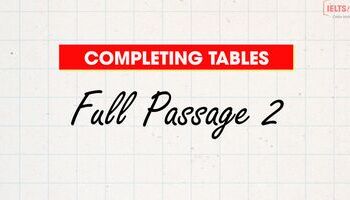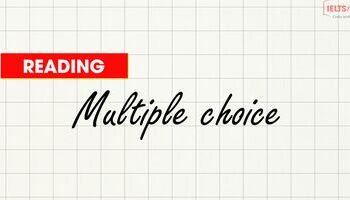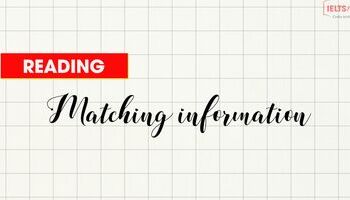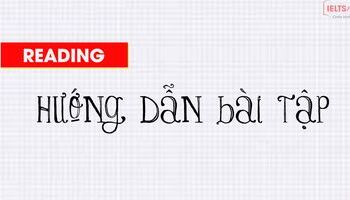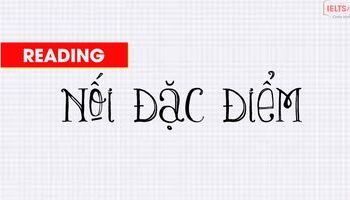I. REVIEW
Chào mọi người, hôm nay chúng ta cùng nhau review lại chiến thuật làm bài kết hợp giải mẫu một bài đọc với dạng bài tập Completing Tables nhé.
Khi làm bài tập dạng này, các bạn chú ý:
- Số lượng từ được cho phép điền vào một vị trí
- Dự đoán trước loại từ có thể điền vào vị trí cần (Noun/Verb/Adj/Adv)
- Từ cần điền sẽ đi gần những keywords nào. Tìm synonyms hoặc paraphrases của những keywords đó
- Check lại đáp án
II. FULL PASSAGE
Obtaining
Linguistic
Data
A. Many procedures are available for obtaining data about a language. They range from a carefully planned, intensive field investigation in a foreign country to a casual introspection about one’s mother tongue carried out in an armchair at home.
B. In all cases, someone has to act as a source of language data — an informant. Informants are (ideally) native speakers of a language, who provide utterances for analysis and other kinds of information about the language (e.g. translations, comments about correctness, or judgments on usage). Often, when studying their mother tongue, linguists act as their own informants, judging the ambiguity, acceptability, or other properties of utterances against their own intuitions. The convenience of this approach makes it widely used, and it is considered the norm in the generative approach to linguistics. But a linguist’s personal judgments are often uncertain, or disagree with the judgments of other linguists, at which point recourse is needed to more objective methods of enquiry, using non-linguists as informants. The latter procedure is unavoidable when working on foreign languages, or child speech.
C. Many factors must be considered when selecting informants – whether one is working with single speakers (a common situation when language has not been described before), two people interacting small groups or large-scale samples. Age, sex, social background and other aspects of identity are important, as these factors are known to influence the kind of language used. The topic of conversation and the characteristics of the social setting ( e.g. the level of formality ) are also highly relevant, as are the personal qualities of the informants (e.g. their fluency and consistency ). For large studies, scrupulous attention has been paid to the sampling theory employed, and in all cases, decisions have to be made about the best investigative techniques to use.
D. Today, researchers often tape-record informants. This enables the linguist’s claims about the language to be checked, and provides a way of making those claims more accurate (“difficult” pieces of speech can be listened to repeatedly). But obtaining naturalistic, good-quality data is never easy. People talk abnormally when they know they are being recorded, and sound quality can be poor. A variety of tape-recording procedures have thus been devised to minimize the “observer’s paradox” (how to observe the way people behave when they are not being observed). Some recordings are made without the speakers being aware of the fact- a procedure that obtains very natural data, though ethical objections must be anticipated. Alternatively, attempts can be made to make the speaker forget about the recording, such as keeping the tape recorder out of sight, or using radio microphones. A useful technique is to introduce a topic that quickly involves the speaker, and stimulates a natural language style (e.g. asking older informants about how times have changed in their locality )
E. An audio tape recording does not solve all the linguist’s problems, however. Speech is often unclear and ambiguous. Where possible, therefore, the recording has to be supplemented by the observer’s written comments on the non-verbal behavior of the participants, and about the context in general. A facial expression, for example, can dramatically alter the meaning of what is said. Video recordings avoid these problems to a large extent, but even they have limitations (the camera cannot be everywhere), and transcriptions always benefit from any additional commentary provided by an observer.
F. Linguists also make great use of structured sessions, in which they systematically ask their informants for utterances that describe certain actions, objects or behaviour. With a bilingual informant, or through use of an interpreter, it is possible to use translation techniques (‘How do you say table in your language?’). A large number of points can be covered in a short time, using interview worksheets and questionnaires. Often , the researcher wishes to obtain information about just s single variable, in which case a restricted set of questions may be used a particular feature of pronunciation, for example, can be elicited by asking the informant to say a restricted set of words. There are also several direct methods of elicitation, such as asking informants to fill in the blanks in a substitution frame (e.g. I___ see a car), or feeding them the wrong stimulus of correction (‘is it possible to say I no can see?’)
G. A representative sample of language, compiled for the purpose of linguistic analysis, is known as a corpus. A corpus enables the linguist to make unbiased statements about frequency of usage, and it provides accessible data for the use of different researchers. Its range and size are variable. Some corpora attempt to cover the language as a whole, taking extracts from many kinds of text, others are extremely selective, providing a collection of material that deals only with a particular linguistic feature. The size of the corpus depends on practical factors, such as the time available to collect, process and store the data it can take up to several hours to provide an accurate transcription of a few minutes of speech. Sometimes a small sample of data will be enough to decide a linguistic hypothesis; by contrast, corpora in major research projects can total millions of words. An important principle is that all corpora, whatever their size, are inevitably limited in their coverage, and always need to be supplemented by data derived from the intuitions of native speakers of the language, through either introspection or experimentation.
Questions 32-36
Complete the table below
Choose NO MORE THAT THREE WORDS from the passage for each answer
Write your answers in boxes 32-36 on your answer sheet.
| METHODS OF OBTAINING LINGUISTIC DATA | ADVANTAGES | DISADVANTAGES |
| 32……as informant | Convenient | Method of enquiry set objective enough |
| Non-linguist as informant | Necessary with 33……and child speech | The number of faction to be considered |
| Recording an informant | Allows linguists’ claims to be checked | 34……of sound |
| Videoing an informant | Allows speakers’ 35…… to be observed | 36……might miss certain things |
III. DISCUSSION
Các em đã chọn đáp án nào và suy luận ra sao nhỉ? Chúng ta cùng nhau thảo luận nhé
Lưu ý không điền nhiêu hơn 3 từ tại một vị trí
(32) So sánh đối chiếu với các method khác trong cùng bảng, chúng ta dự đoán đáp án có thể là người, hoặc một V-ing nào đấy. Đi chung với từ khóa “informant". Đứng trước các method khác trong bảng
-->> Often, when studying their mother tongue, linguists act as their own informants,
-->> Đáp án: Linguist
(33) Cần tìm một danh từ, đi chung với từ khóa “child speech” và “non linguist”
-->> But a linguist’s personal judgments are often uncertain, or disagree with the judgments of other linguists, at which point recourse is needed to more objective methods of enquiry, using non-linguists as informants. The latter procedure is unavoidable when working on foreign languages, or child speech.
-->> Đáp án: Foreign language
(34) Cần tìm một từ đi chung với key word “sound” và thể hiện ý tiêu cực (nằm trong mục disadvantages). Bên cạnh đó, xuất hiện trong đoạn dùng phương pháp Recording
-->> But obtaining naturalistic, good-quality data is never easy. People talk abnormally when they know they are being recorded, and sound quality can be poor.
-->> Đáp án: The poor quality of
(35) Cần một danh từ đi chung với động từ “observed” và tạo nên sự khác biệt cho phương pháp Videoing
-->> Where possible, therefore, the recording has to be supplemented by the observer’s written comments on the non-verbal behavior of the participants, and about the context in general.
-->> Đáp án: Non-verbal behavior
(36) Cần một danh từ đóng vai trò chủ ngữ
-->> Video recordings avoid these problems to a large extent, but even they have limitations (the camera cannot be everywhere)
-->> Đáp án: Video recordings
Bài tập này không hề khó nếu chúng ta có chiến thuật làm bài rõ ràng và kỹ năng scan tốt đúng không các bạn. Các bạn hãy thử sức với những bài tập Reading- Completing Tables khác đến từ IELTS- Fighter nhé <3
Chúc bạn học tốt <3
